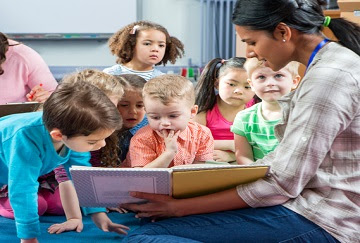Polyglot Pioneers: Empowering Kids in a World of Words
Introduction
In the dynamic tapestry of Abu Dhabi, where diverse languages intertwine to create a rich cultural mosaic, Spring Fields Nurseries emerges as a leading force in early childhood education. Recognized as the best playschool in Abu Dhabi, Spring Fields Nurseries understands the profound impact of multilingualism on a child's overall development. Through a nurturing atmosphere and innovative teaching methods, this esteemed playschool embodies the principles explored in this article, fostering cognitive growth, effective communication, and a genuine appreciation for linguistic diversity. Join us at Spring Fields Nurseries as we embark on a journey to unlock the inherent genius within each child, equipping them for a globally interconnected future.
In our increasingly interconnected world, multilingualism has become a valuable asset, providing access to diverse cultures, enhancing cognitive abilities, and broadening career opportunities. As children embark on their educational journey, exposure to multiple languages from an early age lays the foundation for lifelong learning and global citizenship.
Definition of Multilingualism
Multilingualism, the ability to fluently use multiple languages, is a hallmark of our globalized society. It encompasses both bilingualism, mastery of two languages, and the ability to communicate effectively in more than two.
Importance of Language Skills in Children
Language serves as the cornerstone of communication, thought, and cultural expression. For children, language acquisition is a critical developmental stage, shaping cognitive, social, and emotional growth. Multilingualism enhances these benefits, providing a gateway to a broader world of knowledge and understanding.
Benefits of Multilingualism
The advantages of multilingualism extend beyond the ability to converse in multiple languages. Research consistently demonstrates a range of cognitive benefits associated with multilingualism, including:
1. Enhanced cognitive flexibility: Multilingualism strengthens executive functions, improving memory, problem-solving skills, and decision-making abilities.
2. Improved communication skills: Multilingual children develop a deeper understanding of language structure and nuances, leading to enhanced communication skills in all languages they speak.
3. Cultural awareness: Multilingualism fosters a deeper appreciation of different cultures, promoting empathy, cross-cultural understanding, and global citizenship.
Myths and Misconceptions
Despite overwhelming evidence supporting multilingualism, persistent myths may hinder parents' decision to raise their children multilingually.
1. Fear of confusion: Research shows that multilingual children do not experience language confusion but rather develop distinct mental representations for each language.
2. Delayed language development: Early exposure to multiple languages enhances overall language development and does not hinder language acquisition.
3. Difficulty in academic performance: Multilingualism does not negatively impact academic performance; instead, it can lead to better academic outcomes.
How to Introduce Multiple Languages
Effectively introducing multiple languages to children requires a supportive and stimulating environment. Key strategies include:
1. Early exposure: Begin exposing children to multiple languages from birth or as early as possible.
2. Incorporate language in daily routines: Integrate languages into everyday activities like reading, singing, and playtime.
3. Interactive learning methods: Use interactive methods such as games, songs, and storytelling to make language learning enjoyable and engaging.
Case Studies
Numerous case studies provide compelling evidence of the positive impact of multilingualism. Children raised in multilingual environments have demonstrated exceptional cognitive abilities, strong communication skills, and a deep appreciation for diverse cultures.
1. Success stories of multilingual children: Multilingual children often excel academically, showcasing enhanced problem-solving skills, creativity, and adaptability.
2. Impact on academic achievements: Studies indicate that multilingual students often outperform their monolingual peers in standardized tests and academic achievements.
Challenges Faced by Parents
While raising multilingual children is a rewarding experience, parents may encounter challenges.
1. Balancing languages at home: Creating a balance between languages can be challenging, especially in environments where a single language dominates.
2. Addressing societal pressures: Societal pressures to prioritize the majority language may create doubts about the benefits of multilingualism.
3. Strategies for overcoming challenges: Parents can overcome these challenges by emphasizing the value of multilingualism, seeking support from other multilingual families, and utilizing language resources.
Technology and Multilingualism
Technology has revolutionized language learning, providing a plethora of resources for parents and children.
1. Language learning apps: Interactive language learning apps make the process enjoyable for children.
2. Online resources for parents: Online platforms offer valuable information and support for multilingual families.
3. Virtual language exchange platforms: These connect children with native speakers worldwide, fostering authentic language learning experiences.
Multilingual Education Programs
Structured multilingual education programs provide opportunities for children to develop their linguistic abilities.
1. Benefits of bilingual schools: Bilingual schools offer a supportive environment for children to learn two languages simultaneously.
2. Extracurricular language programs: Additional programs provide opportunities for children to enhance their language skills.
3. Integrating multilingualism in the curriculum: Schools can foster a global perspective by incorporating multilingualism into the curriculum.
Building a Supportive Community
Creating a supportive community is essential for nurturing multilingualism.
1. Networking with other multilingual families: Building connections with other multilingual families provides encouragement, shared experiences, and valuable resources.
2. Community events and language festivals: Celebrating linguistic diversity through events fosters language learning opportunities.
Tips for Nurturing Language Skills
Parents play a crucial role in nurturing language skills, whether raising multilingual children or not.
1. Encouraging reading in different languages: Reading exposes children to rich vocabulary, grammar structures, and cultural contexts, fostering language development.
2. Travel as a language-learning opportunity: Travel provides authentic language immersion experiences, allowing children to practice their language skills in real-world settings.
3. Celebrating linguistic diversity at home: Creating a home environment that celebrates linguistic diversity encourages children to embrace multilingual abilities and appreciate different languages.
Expert Insights
Experts in language development and education offer valuable insights into fostering multilingualism.
1. Interviews with language development specialists: Experts provide guidance on effective strategies for raising multilingual children.
2. Tips from educators on fostering multilingualism: Educators share practical tips for incorporating multilingualism into the classroom and supporting multilingual students.
The Future of Multilingualism
Multilingualism is gaining global recognition as a valuable asset for individuals and societies.
1. Global perspective on language diversity: There is a growing recognition of the importance of multilingualism in an increasingly interconnected world.
2. Anticipated trends in language education: Anticipated trends include technology-enhanced language learning, personalized experiences, and a focus on cultural competency.
Conclusion
Unlocking the potential of multilingualism is a gift we can give to our children, fostering cognitive prowess, effective communication, and a profound appreciation for diverse cultures. As we navigate the evolving landscape of education, choosing environments that embrace linguistic diversity is crucial. In Abu Dhabi, Spring Fields Nurseries stands out as the best playschool, providing a nurturing space where children thrive as multilingual learners. With a commitment to holistic development and a global perspective, Spring Fields Nurseries sets the stage for a future where linguistic diversity is not just celebrated but becomes a cornerstone for success. Enrich your child’s journey at the Best Playschool in Abu Dhabi.
Multilingualism empowers children to navigate an increasingly diverse world, enhancing cognitive abilities, communication skills, and cultural awareness. By embracing multilingualism from an early age, we open doors to a lifetime of opportunities and prepare children to thrive in a global society.


Comments
Post a Comment